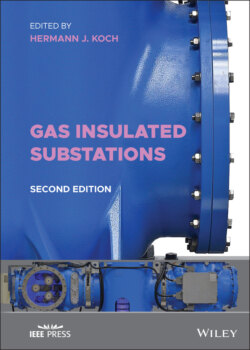Читать книгу Gas Insulated Substations - Группа авторов - Страница 20
1.1.3 Content of the Tutorial
ОглавлениеThe experts of K2 work group are responsible for the content and presentation of the GIS/GIL tutorials. The content is under constant revision of working group K2 of the GIS subcommittee. The following topics have been presented:
Overview: Gives an overview of the content and organization of the tutorial.
GIS Basics: Here the basic knowledge of GIS is explained for practical applications.
GIS Applications: Here a wide area of applications is given to show the large variations.
GIL Basics: Here the basic knowledge of GIL for practical applications is given.
GIL Applications: Here many applications in typical surroundings and laying methods are explained.
Mixed Technology Switchgear: Here the compact or hybrid type of partly gas‐insulated and air‐insulated technology is given.
SF6: Here the knowledge of handling, atmospheric impact, and recycling is given.
GIS Overloading: Here the specific conditions and rules for overloading of GIS are explained.
Theory: Here the physical theory and gas‐insulated systems with SF6 is explained.
Life Cycle Assessment: Here the impact for the lifetime of GIS is explained.
Future Development: Here the next steps in development are explained for GIS.
GIS Specification: Here the rules and conditions for correct specification of GIS are explained.
GIS Monitoring: Here the monitoring systems for control and supervision are explained.
Gas Handling: Here details of correct gas handling when dealing with SF6 are given.
Digital Communication IEC 62271‐3: Here the impact of digital communication in substations is explained.
Revision of C37.122 GIS: Here information of the latest revision of the GIS standard is given.
Moisture Guide: Here information is given on how to monitor and handle the moisture of SF6.
Alternative Gases: Here information is given on alternative gases to SF6 with lower or no global warming potential.
Determining When to use GIS: Here information is given to find the right decision when to use GIS instead of AIS.
Specification Development: Here information is given on how to write a good specification for GIS.
Examples for GIS interfaces: Here information is given on the different interfaces to GIS and how to specify.
Guidelines for GIS: Here information is given on aspects for using GIS based on IEEE C37.122.1.
Guidelines for on‐site tests: Here information is given on how to test GIS after erection on‐site.
Mobile GIS: Here information is given on the use of GIS for mobile substation installations.
Moscow street house project and Toronto Junction Point GIS need case studies for the use of GIS and GIL.
Underground Substations and Special buildings: Here information is given on special applications only possible with GIS.
Condition Assessment: Here information is given on the possibilities to evaluate the condition of GIS after years of use.
Substations Resilience: Here information is given to show the possibilities for a resilience use of GIS in the power network.
Vacuum HV Switching: Here information is given on the use of vacuum switches and circuit breaker for voltages up to 500 kV.
Low Power Instrument Transformers (LPIT): Here information is given for the use of LPIT in GIS and its advantages.
Digital Twin of GIS and GIL: Here information is given of how GIS and GIL can be digitalized.
Offshore GIS: Here information is given on the offshore applications of GIS.
DC GIS: Here information is given on the use of direct current (DC) GIS.
Digital substation: Here information is given on digital substations using GIS.
The last nine topics have not been presented in tutorial until now, they are innovative part of this GIS book.
